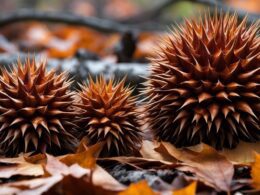Are you ready to learn about a unique flower that only blooms once a year and smells really bad?
Meet the Titan Arum, also known as the ‘corpse flower.’ This fascinating plant is native to the rainforests of Sumatra, Indonesia, and is known for its impressive size and pungent odor.
As you may have guessed, the Titan Arum gets its nickname from the scent it emits when it blooms, which is often described as similar to rotting flesh.
But don’t let this turn you off from learning more about this amazing flower! Despite its unpleasant aroma, the Titan Arum is truly a wonder of the natural world, with a fascinating biology and a rich cultural significance.
So let’s dive in and explore the world of the Titan Arum together.
Overview of the Titan Arum
Get ready to be amazed by the incredible Titan Arum, a rare and pungent plant that graces us with its presence for just a fleeting moment. The Titan Arum only blooms once a year, and when it does, it emits a smell that has been compared to rotting flesh.
The plant is native to the rainforests of Sumatra, where it grows under specific conditions that must be replicated in order to cultivate it elsewhere. To grow the Titan Arum, you must recreate its natural habitat as closely as possible. The plant requires high humidity and plenty of warmth, so it’s best to keep it in a greenhouse or other controlled environment.
The soil should be a mixture of peat moss and sand, as this mimics the soil found in its native range. In addition, the plant needs plenty of space to grow, as it can reach heights of up to 12 feet.
Propagation techniques for the Titan Arum are highly specialized and require a lot of patience. The plant grows from a corm, which is a bulb-like structure that stores nutrients for the plant. Corms can take up to seven years to mature, and the plant itself can take up to 10 years to bloom.
When the Titan Arum finally does bloom, it’s a sight to behold, with its majestic structure and unique odor. If you’re lucky enough to witness this amazing plant in person, it’s an experience you won’t soon forget.
Unpleasant Scent and Pollination
When you approach the Titan Arum, the first thing you’ll notice is its unpleasant scent. This odor is caused by the chemical composition of the flower’s volatile compounds, which include sulfur and nitrogen-based chemicals.
Despite the smell, the Titan Arum is an important player in its ecosystem. It attracts pollinators like carrion beetles and flesh flies with its scent and provides a food source for them.
Chemical Composition of the Odor
Exploring the chemical makeup of its scent, we can uncover why this rare bloom emits such a pungent odor. The flower in question contains various chemical compounds that contribute to its unpleasant scent.
These compounds include trimethylamine, dimethyl disulfide, and dimethyl trisulfide, all of which are classified as sulfurous compounds.
While some flowers rely on attractive scents to entice pollinators, this particular bloom has evolved to emit a foul odor. The sulfurous compounds in its scent serve as a defense mechanism, deterring predators from consuming the plant.
By emitting an unpleasant odor, the flower is able to protect itself and ensure its survival for the next blooming season. Although the scent may be unpleasant to humans, it is a crucial aspect of the flower’s survival and reproductive success.
Attraction of Pollinators
The stinky scent of this once-a-year flower has a clever purpose: to attract pollinators that are drawn to the pungent aroma. Pollinator behavior plays a crucial role in the flower’s survival, and the unique floral morphology is specifically designed to appeal to certain insects.
The strong smell of the flower is intended to attract flies and beetles, which are known to have a preference for malodorous blooms. Though the odor may be off-putting to humans, it serves as a beacon for these insects, guiding them towards the flower’s hidden nectar and pollen.
The shape and color of the flower also play a role in attracting pollinators, with some species having deep, tubular structures that are perfect for long-tongued bees or butterflies.
Understanding the relationship between pollinator behavior and floral morphology can help us appreciate the intricate ways in which plants have evolved to survive and reproduce. Though the scent of this flower may not be pleasant to us, it’s a vital part of the ecosystem, providing food and habitat for a variety of insect species.
So, the next time you encounter a stinky bloom, remember that it has a purpose beyond just its bad smell.
Role in the Ecosystem
The unique scent and morphology of the flower that only blooms once a year and smells bad serve a crucial role in the ecosystem. The plant attracts specific pollinators such as flies, beetles, and carrion-loving insects that are drawn to the strong odor. These pollinators play a significant role in the ecosystem by helping to transfer pollen from one plant to another, which is essential for the survival and reproduction of many plant species.
The importance and impact of this plant cannot be underestimated. It serves as a vital source of food and shelter for insects, which in turn support the larger food web. The plant also helps to maintain the balance of the ecosystem by controlling the population of certain insects and providing nutrients for other organisms.
Although the flower may not appear desirable to humans, its unique characteristics make it an essential component of a healthy ecosystem.
Does the Flower That Blooms Once a Year and Smells Bad Take 40 Years to Bloom?
The flower blooming time of the rare once-a-year bloomer with an unpleasant odor has long been a subject of fascination. Many believe it takes 40 years for this peculiar flower to bloom. However, the scientific community remains divided on this matter, as further research is needed to determine the exact duration of its blooming cycle.
Cultural Significance
You’ll be fascinated to learn about the cultural significance of this rare and pungent plant that graces us with its presence for a brief period each year. This plant is the corpse flower, also known as the titan arum. Despite its foul smell, it has played an important role in various cultural traditions and practices throughout history.
In Indonesia, where the corpse flower is native, it is considered a symbol of death and rebirth. The plant’s blooming cycle, which occurs only once every few years, is seen as a representation of the cycle of life and death. The local people also believe that the plant has medicinal properties and use it for various purposes.
In Western cultures, the corpse flower has gained popularity in recent years as a curiosity and attraction. Many botanical gardens and museums display the plant during its blooming period, drawing in crowds of curious visitors. The plant’s rarity and unique appearance make it a valuable addition to any collection, and it has become a popular subject of art and literature as well.
Despite its unpleasant smell, the corpse flower has managed to capture the imagination of people from all over the world.
Record-breaking Titan Arums
Get ready to be amazed by the titan arums, breaking records with their towering heights and stunning beauty. These exotic plants are native to Sumatra, but have gained worldwide distribution due to their unique characteristics.
Titan arums are known for their ability to grow up to 10 feet tall and produce the largest unbranched inflorescence in the world, which can reach up to 12 feet in circumference. Despite their impressive size, titan arums have a reputation for producing a putrid odor that resembles rotting flesh. This smell attracts pollinators such as carrion beetles and flies, which help to ensure the plant’s survival.
Titan arums only bloom once a year, making their brief appearance all the more special. In addition to their unusual appearance and scent, these plants are also important for conservation efforts, as they are considered endangered in their natural habitat. Conservation efforts for titan arums include protecting their native habitat and promoting responsible cultivation practices.
These plants require specific conditions to thrive, such as high humidity and a warm environment, making them challenging to grow in some regions. However, their unique characteristics make them a valuable addition to botanical collections and a fascinating subject for plant enthusiasts.
So next time you come across a titan arum, take a moment to appreciate its beauty and the important role it plays in the natural world.
Visiting a Titan Arum
After learning about the Titan Arums, you’re excited to visit one in person. But before you go, make sure to prepare for your visit. Here are some tips to keep in mind:
-
Dress appropriately: Since the Titan Arum is located in a warm and humid environment, wear light and breathable clothing. Also, wear comfortable shoes as you’ll be standing for a while.
-
Bring a camera: You don’t want to miss the opportunity to capture the Titan Arum’s beauty on camera. Make sure to bring a camera with you and charge it beforehand.
-
Plan your visit: Since the Titan Arum blooms only for a short time, plan your visit accordingly. Check the garden’s website beforehand and see if there are any special events or guided tours.
-
Be patient: The Titan Arum’s bloom can take up to 48 hours to fully open, so don’t be discouraged if it hasn’t fully bloomed when you arrive. Take your time and enjoy the experience.
Once you’ve arrived, take some time to admire the Titan Arum’s unique beauty and smell. Since it only blooms once a year, you’re lucky to witness this rare event.
Here are some photography tips to keep in mind:
-
Use natural light: The Titan Arum is best photographed in natural light, so avoid using flash. Instead, try to capture it in bright, indirect sunlight or during the golden hour.
-
Get creative: Take photos from different angles and perspectives to capture the Titan Arum’s unique shape and size. You can also experiment with close-ups and wide-angle shots.
-
Focus on the details: The Titan Arum has intricate details that are worth capturing. Try to focus on the texture and patterns of the flower.
By following these tips, you’ll be able to capture the beauty of the Titan Arum and create lasting memories. So go ahead, plan your visit, and enjoy the experience!
Frequently Asked Questions
What other plants have a similar unpleasant scent to the Titan Arum?
Looking for gardening alternatives to the notoriously unpleasant-smelling titan arum? There are plenty of other plants out there with similarly pungent aromas.
One option is the corpse flower, which also has a putrid scent and blooms infrequently. Another possibility is the skunk cabbage, which emits a strong odor to attract pollinators.
While these plants may not be everyone’s cup of tea, they can add a unique touch to your garden without the hassle of dealing with a temperamental titan arum. So if you’re looking to diversify your collection of smelly plants, consider these alternatives and embrace the unconventional.
Is there any way to control or minimize the smell of the Titan Arum?
If you’re looking to grow a titan arum, you may be wondering how to control its notoriously unpleasant odor. Fortunately, there are a few cultivation techniques that can help minimize the smell.
One option is to keep the plant in a well-ventilated area, which can help disperse the scent. Additionally, you can try using activated carbon filters or other air purifiers to help neutralize the odor.
While you may not be able to completely eliminate the smell, these methods can help make it more bearable. With a little care and attention, you can enjoy the unique beauty of the titan arum without being overwhelmed by its signature scent.
How long does it take for the Titan Arum to bloom after it is planted?
If you’re interested in planting a titan arum, it’s important to know what to expect in terms of timeframe. These plants can take anywhere from 7-10 years to bloom after they’ve been planted, so patience is definitely key.
However, there are certain techniques you can use to help speed up the process, such as providing the plant with plenty of sunlight and keeping it in a warm, humid environment.
As you wait for your titan arum to bloom, be sure to monitor its growth and provide it with the care it needs to thrive. With a little bit of effort and patience, you’ll be rewarded with a beautiful and unique plant that only blooms once a year and is sure to impress.
Can the Titan Arum be grown in home gardens or only in specific climates?
If you’re interested in growing the Titan Arum, also known as the ‘corpse flower,’ in your home garden, you’ll need to create a specific environment for it to thrive.
While these plants can be grown indoors, they require a lot of space and the right amount of humidity, warmth, and light. You’ll need to start with a large pot and a well-draining soil mix that’s rich in organic matter.
Keep the plant in a warm, humid location with indirect sunlight and make sure to water it regularly. With proper care, your Titan Arum can grow up to ten feet tall and produce its unique, pungent bloom once every few years.
However, it’s important to note that these plants are not for everyone and may not be suitable for those with sensitive senses or small living spaces.
Are there any medicinal or culinary uses for the Titan Arum?
Have you ever wondered about the potential medicinal or culinary uses of the titan arum?
While some traditional remedies suggest that the plant has healing properties, there is little scientific evidence to support these claims.
Additionally, the ethics of harvesting and selling rare plants for medicinal purposes are a contentious issue.
Despite these controversies, the titan arum remains a fascinating plant to study and admire for its unique characteristics.
Its massive size, rare blooming cycle, and pungent odor make it a captivating subject for botanists and nature enthusiasts alike.
Conclusion
So, now you know all about the Titan Arum! This unique flower only blooms once a year and emits an unpleasant odor to attract pollinators.
Despite its smell, the Titan Arum has cultural significance in many regions and has even broken records for its size.
If you ever have the chance, visiting a Titan Arum in person is a must-see experience. The sheer size and smell of the flower are unforgettable.
So, next time you see a news article or hear about a blooming Titan Arum, make sure to check it out!








